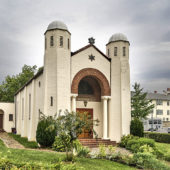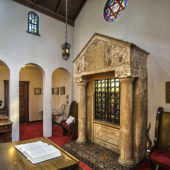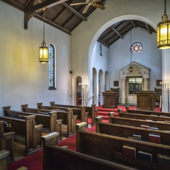An exquisite architectural gem, home to a congregation founded by a Civil War officer.
Founded in 1876 by Major Alexander Hart, the congregation originally held services in members’ homes, then moved to a building on Kalorama street in 1885, the same year it joined the Union for Reform Judaism. According to Temple House of Israel’s website “in 1924, Abraham Weinberg, a prominent merchant, stood up in the old Kalorama Street building one day and said, ‘I’m tired of worshipping in something that looks like a warehouse. I’ll put up half the money for a real synagogue if the congregation will put up the other half.’ He did and they did.”
The congregation purchased a lot on North Market Street from Mary Baldwin College. Sam Collins of T.J. Collins and son designed a new Moorish Revival building for the site. Collins was famous for his design of the Virginia War Memorial in Richmond. The one–story stucco synagogue had a twin gable roof with 3 bays. Decorated with “Early Assyrian motifs”, the facade presented flanking twin towers with suppressed buttresses, and a large arched opening in the central bay, and included Mercer tiles.
All the windows, and a glass screen, were created by Charles Connick of Boston, who also created famous windows for a number of religious buildings, including the rose windows of St. Patrick’s Cathedral and the Cathedral of Saint John the Divine in New York City. The windows were fabricated in Boston and shipped by train to Staunton. Each emblem in the windows represents a fruit or plant that can be found in Israel – olives, grapes, citron, pomegranate, and others. The tiles at the base of the ark were manufactured at the Moravian Pottery and Tile Works in Doylestown, Pennsylvania.
The building was a contributing property to the successful 1984National Register of Historic Places nomination of Gospel Hill as a historic district.
On Temple House of Israel’s website there is an interesting anecdote about the congregation’s founder, Major Hart who suffered a serious leg injury at the Civil War battle of Antietam. He was taken to a private house after the battle. The surgeon said that the leg had to be amputated. The lady of the house begged the surgeon to wait and give her a chance to nurse Hart back to health, proclaiming, “So young and handsome a man should not lose a leg.” She did indeed nurse him back to health, and after the war, Major Hart visited his friend every year. Once during his visit, the lady’s daughter–in–law complained that there was no ham on the table. Major Hart’s hostess replied, “No, there shall be no ham on my table while my ‘Jewish son’ is here.”








